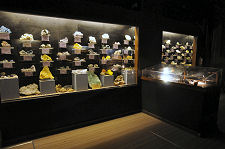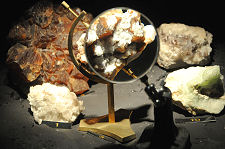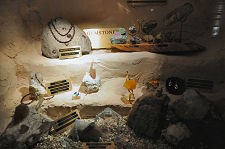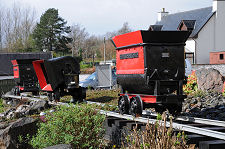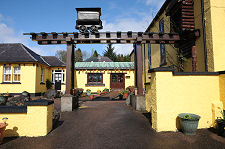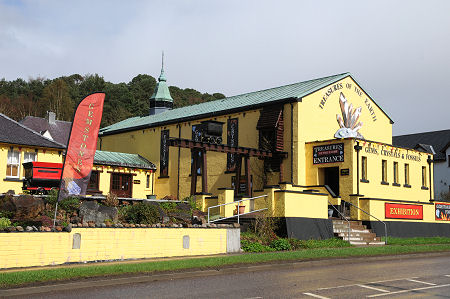 Treasures of the Earth |
On the northern edge of Fort William is the junction at which the road up the Great Glen to Inverness parts company with the evocatively named "Road to the Isles", the A830 to Mallaig and the Skye ferry. Taking a left turn along the A830 leads you into Corpach and directly past the front door of the large yellow building shown in the header photograph.
This is Treasures of the Earth, home to one of Europe's finest private collections of crystals, gemstones and fossils. Lochaber is an area not over-endowed with all-weather attractions, and Treasures of the Earth is certainly one of them. But for anyone with any interest at all in geology, minerals, or fossils (or who simply enjoys very beautiful and often very rare objects) it really is worth pausing en route, even if the weather is more suited to enjoying the beaches of Morar. Though perhaps "pause" is the wrong word. Some 6,000 square feet of space is given over to the displays in the main building, many based on or housed within simulated rock faces, and you could quite happily spend a few hours here.
The displays start in the grounds between the car park and the main building, where three tipping mining tubs are shown on some relaid narrow gauge track. These started their lives at a barytes mine near Eaglesham. Projecting from the upper level of the main building is a further length of rails supporting another tub caught in a very "Indiana Jones" pose. From here the main entrance to the exhibition is directly ahead of you, at the road end of the building, while the excellent shop in which you end your tour is in the ancillary building off to your left.
The main exhibition hall has a ground floor and a mezzanine level which extends about two thirds of the way along the building, with a central cut-away, providing a fine viewing gallery at the far end. Light levels are low, and when you first enter it takes a few moments to adjust. The reason for the dim lighting becomes clear when you begin to look at the exhibits, which are beautifully lit to show them at their very best.
The mezzanine level is the more open space, and also employs more traditional forms of display. Here you can find a series of display cases showing off a magnificent collection of very large samples of minerals. Here, too, are displays on the concept of geological time, and on the formation of fossils, together with some spectacular fossils to illustrate the results of the process. We were especially impressed by the fossilised icthyosaurus in which an impression appeared to have been left of every bone, scale and tooth, bringing home forcibly that this was not an animal you would have wanted to meet while it was living. The same feeling is induced, with even greater conviction, elsewhere in the building when you come face to face with the skull (and teeth) of a sabretooth tiger.
The far end of the mezzanine floor is in some ways the best place to appreciate the spectacular displays at the far end of the hall, where a hundred foot mural gives a suitably prehistoric backdrop to many of the items on display. On a level with the upper floor a 20ft wingspan pteranodon is suspended, as if soaring looking for food: and is another exhibit you would not want to meet in real life.
Highlights of this part of the exhibition include a huge chunk of amber, a dinosaur egg nest, and a series of sections of basalt columns. To one side of the hall, a pair of upright amethyst geodes flank the entrance to a cave-like area. On entry this seems completely dark, but this soon changes when an invisible ultra violet light is turned on, causing an array of minerals to fluoresce spectacularly in different colours. The illumination then turns to visible light, and you can see what the minerals normally look like, before the cycle repeats. The effect is fascinating.
The area under the mezzanine floor is given over to a series of exhibits set into the walls of imitation "stone" alcoves. Some of these are absolutely entrancing. One display houses a collection of rocks which originally formed parts of meteorites, while another contains minerals recovered from the mines at Strontian. Those more attracted to glister will be drawn to the display showing gold in all its forms, from ore and nuggets through to minted coins. Perhaps the most amazing display is one containing a number of emeralds. This can at first seem a little uninspiring, until you read the notice pointing out that the grey rock-like object at the back of the display is one of the world's largest emeralds, weighing in at 26lbs.
The shop is home to a wide range of attractive and interesting objects on the theme of the exhibition, including jewellery, books and minerals, up to and including (when we visited) a pair of large amethyst geodes that would challenge the suspension of most visitors' cars.
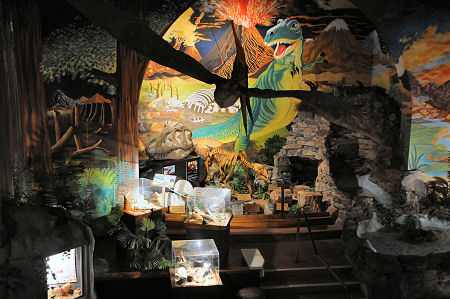 Prehistory Area, Including 20ft Wingspan Pteranodon |
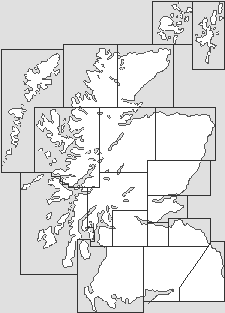
|
|
|
Visitor InformationView Location on MapCorpach, Fort William, PH33 7JL. Tel: 01397 772283. info@treasuresoftheearth.co.uk Grid Ref: NN 094 769 treasuresoftheearth.co.uk Opening Hours Admission Accessibility What3Words Location: ///huddle.instilled.active |
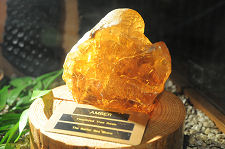 Amber |
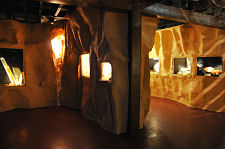 Displays on the Ground Floor |
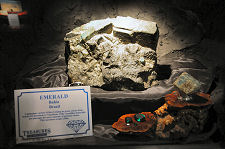 Emeralds |
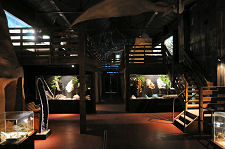 Displays and Galleries |
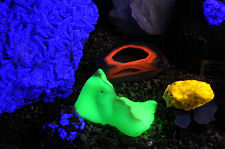 Fluorescing in Ultra Violet Light |
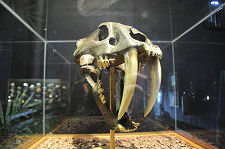 Skull of a Sabretooth Tiger |
